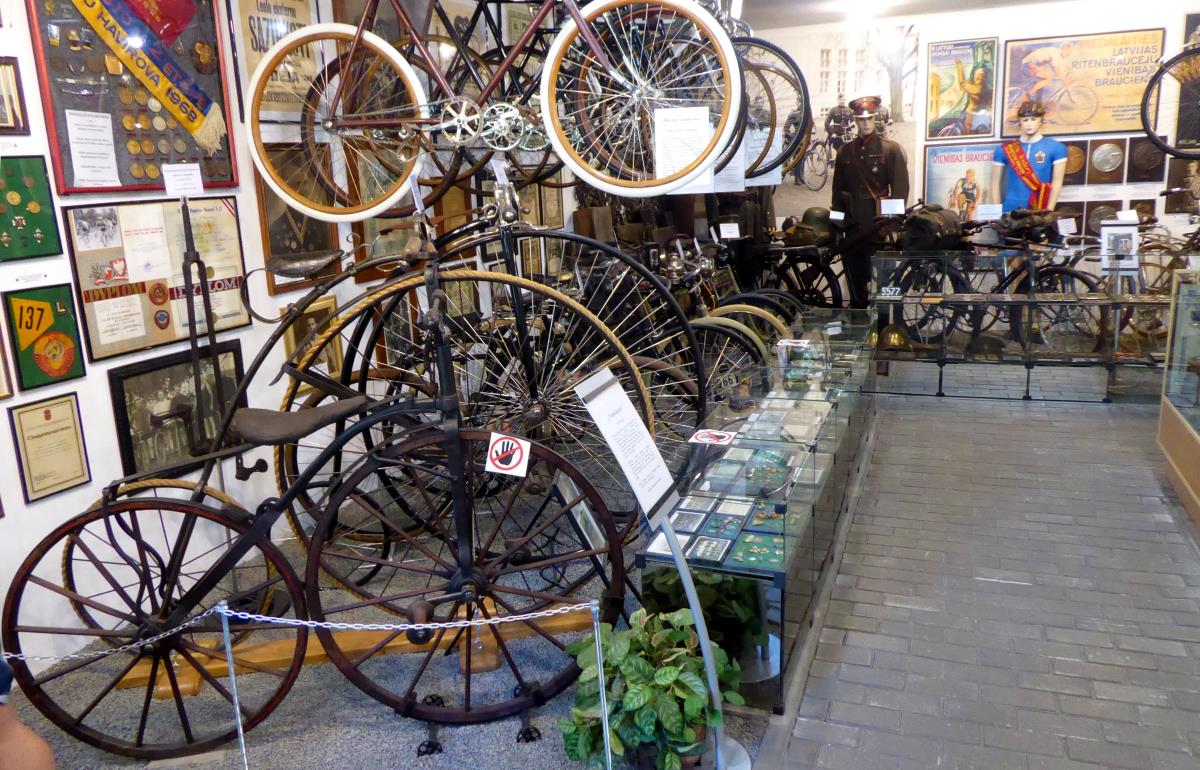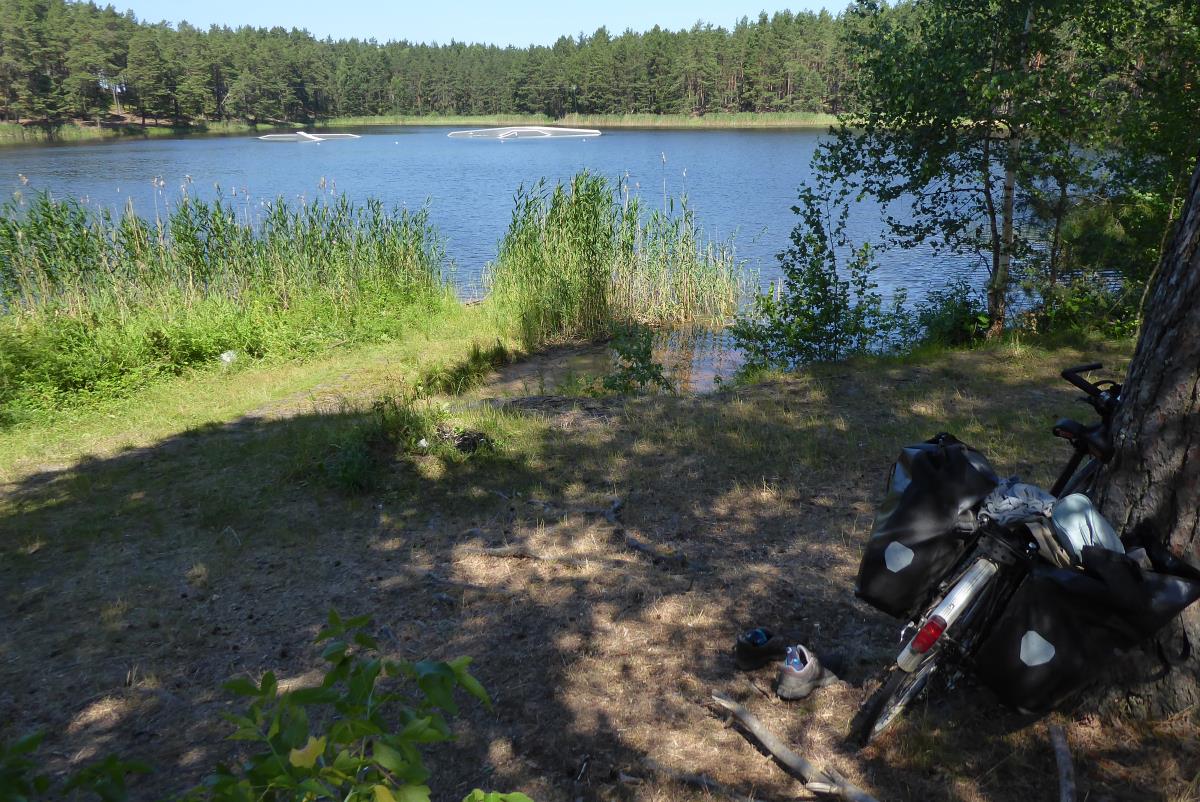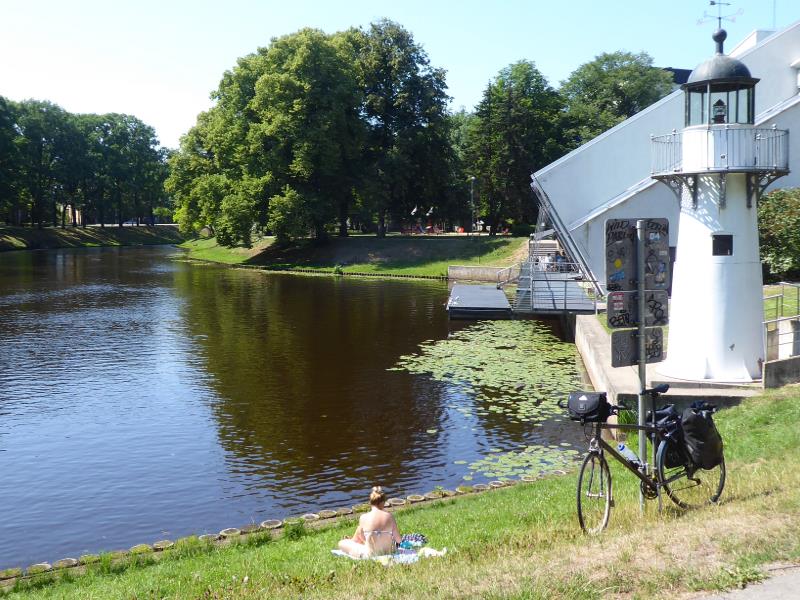It’s only 35 miles between Sigulda and Riga. The road route is unsuitable for bikes because it’s a busy expressway. Locals ride on the shoulder, but it can change abruptly in width and surface. I’m all for experiences of the real, everyday, local Latvia, but A&E is not one of them.

However, the cycle route is unsuitable for bikes too. At least, not bikes like mine. If you have a full-sus fat-tyred MTB and gold-standard medical insurance, then the tree roots, boulders, scrambled climbs and big dropoffs of the riverside path may well be inviting. Less inviting for my narrow-tyred borrowed hybrid.

So instead I went on two sides of a tarmac triangle via Saulkrasti, a Baltic beach resort to the north. The quiet sunny roads out of Sigulda could have been in East Yorkshire.

At Bīriņi, whose castle and grounds had not yet opened for the day – it was still only eight – I breakfasted on petrol station pastries by the lake. It was a bit early for a dip.

More flat quiet roads – though I’m beginning to notice some suicidal overtaking during the brief pulses of motor traffic – got me to Saulkrasti, recommended as a seaside day-trip from Rīga by my guidebook.

I couldn’t find the centre of Saulkrasti, though of course I was thinking wrong: I was looking for a Brit-style seaside prom with amusement arcades, tat shops selling sticks of rock, and Wetherspoons. This was more Baltic. No such commercial centroid here, just a modest series of beaches curtained off from the road by cool pine woods. I couldn’t see the wood for the trees, as it were.

Eventually I found the helpful tourist info in the very low-key ‘centre of town’ who supplied me with the two most vital resources for a touring cyclist: fresh water, and wifi.

I stopped to watch a beach volleyball tournament in a ‘stadium’ right there on the beach and enjoyed a quick paddle.

But now I had somewhere to visit. The Saulkrasti Bike Museum is a gem: a two-gallery collection south of the town built up passionately since 1977 by Jānis Seregins and his son Guntis, who gave me a guided tour.

Everything is from Latvia, and tells the country’s history since the late 1800s – through German, Russian, western and now global times – through the lens of the bike industry.
It’s Latvia through thick and thin, and by gum a lot of the bike frames for the domestic market, designed for clattering from farm to village over rough gravel lanes, are thick rather than thin.

The two galleries are stuffed full of remarkable items, including some eye-opening examples of native tech way ahead of its time. There’s shaft-driven bikes, derailleur gears, airless spring tyres, full-suspension ‘mountain’ bikes (made of wood), reverse-formation tandems (man steering but at back, woman at front), stationary exercise bikes, folders, and even a phone charger. (Yes, a century ago: it was for powering up wartime field telephones.)

Other military bikes include some equipped with rifles and grenades, which would come in handy when cycling in road-rage London. There’s also a touring bike from the 1930s, fitted with bamboo tent poles, which looks heavy and slow but reliable, so not that different to the one I’m riding.

And so much more: an astounding collection of badges – the ones that traditionally decorated the front of the frame – and some minutely accurate reconstructions of vintage bike workshops and shops.
LATVIA FACTS 5
The Latvian language, spoken by just over a million people, is related only to Lithuanian, the other member of the Baltic language family. The written form is immediately recognisable because it has several modified letters of the alphabet that only occur in Latvian: the alphabet is a ā b c č d e ē f g ģ h i ī j k ķ l ļ m n ņ o p r s š t u ū v z ž
The 1940s stock piled up on the shelves is authentic: it came from a bike workshop in Rīga that was walled in one day by the occupying Russians, busily nationalising the thriving local bike factories and dispatching the owners to Siberia. The stock was only rediscovered when the building was demolished decades later.
I was very happy in this haven of bike history, and Guntis clearly knows his stuff. I could have stayed all day, but I had more cycling to do. I lunched on herring from the Top! supermarket opposite in a nearby park, cool and shady under the pine trees, and headed south.

I had a few miles on the A1, which was less dangerous than it sounds. Yes, like Britain’s A1 it’s busy with lorries and fast traffic, but there’s a wide tarmac shoulder that forms a de facto bike lane, and with a tailwind I made fast, easy, if noisy, progress.

Not too fast, though, to notice and stop at a lake where a local family was wild-swimming. I did the same: the water was pretty warm and a bit cloudy, putting me in mind of a tasty unfiltered dark craft beer I’d had the previous night in Sigulda.

The final flat stretch into Rīga on the old main road through woods and past lakes was a bit windy, whichever way you pronounce it, and I stopped often for a water break. As we got closer to the capital there was more suicidal overtaking by some drivers on other drivers, only one of which nearly affected me.

The last few miles into the centre of Rīga was a jumble of good and bad unconnected bike paths, shabby fast roads past derelict factories and side streets. Finally I got to the familiarity of the Old Town’s parks and pedestrian alleys crowded with tourists taking selfies. I rehydrated with a beer and checked into my hostel, very satisfied with my day.

Miles today: 52
Miles since Borderland: 190
